|
|
|
Sort Order |
|
|
|
Items / Page
|
|
|
|
|
|
|
| Srl | Item |
| 1 |
ID:
139616
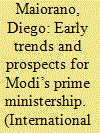

|
|
|
|
|
| Summary/Abstract |
In May 2014 Narendra Modi became India’s Prime Minister in the wake of a historic electoral victory. He has generated two kinds of expectations: on the one hand, his voters expect him to create millions of new jobs for a fast-growing working age population; on the other hand, Hindu extremists hope that he will pursue an aggressive policy aimed at ‘hinduising’ India’s society. The first months of his premiership show that Modi is acting in both spheres, while pursuing a radical centralisation of power in his hands.
|
|
|
|
|
|
|
|
|
|
|
|
|
|
|
|
| 2 |
ID:
125276


|
|
|
|
|
| Publication |
2013.
|
| Summary/Abstract |
Decentralisation is witnessed in some form of sub-national government structure ranging from local governments with high degrees of autonomy, to local agents of the central state with minimal discretion, with numerous variations in between. Decentralisation can involve the power to decide the allocation and distribution of public resources, the power to implement programmes and policies and the power to raise and spend public revenues for these and other purposes.
|
|
|
|
|
|
|
|
|
|
|
|
|
|
|
|
| 3 |
ID:
134311
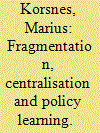

|
|
|
|
|
| Summary/Abstract |
This paper seeks to understand what government mechanisms have allowed China’s wind industry to grow as fast as it has over the past ten years. Instead of formal rules and regulations, this paper focuses on specific sets of institutional conditions that have been crucial in the process of high-speed implementation of wind energy in China. Specifically, fragmentation and centralisation, together with policy experimentation and policy learning, have been fundamental for policy flexibility and institutional adaptability. The paper illustrates that there are benefits and disadvantages to these characteristics, and that inherent qualities of China’s governing system that lead to rapid growth overlap with those that lead to challenges in terms of quality and long-term performance.
|
|
|
|
|
|
|
|
|
|
|
|
|
|
|
|
| 4 |
ID:
148023
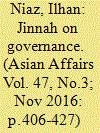

|
|
|
|
|
| Summary/Abstract |
This paper examines the views of Pakistan's founder, Mohammad Ali Jinnah, on a range of issues including sovereignty, civil-military relations, the civil service, industrialization, religion and the state, and national integration. Relying on Jinnah's own views, it reveals that selective engagement with what Jinnah thought has done no favours to Pakistan. Indeed, Pakistan has for all practical purposes, rejected nearly every policy prescription that its founder believed in and effectively repudiated what Jinnah stood for. While much attention has been paid to Jinnah's role in the partition of India or in the politics of the Indian Freedom Movement and the Pakistan Movement, comparatively little has been written about Jinnah's views on governance. This paper tries to initiate the process of filling this gap in the hope of generating a more holistic debate about what Pakistan's founder stood for as a statesman and state builder.
|
|
|
|
|
|
|
|
|
|
|
|
|
|
|
|
| 5 |
ID:
193237
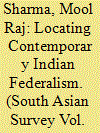

|
|
|
|
|
| Summary/Abstract |
Indian federalism is a peculiar model designed to accomplish the necessities of a heterogeneous and multifaceted society. The constitutional framework of federalism spells out that the fate of the states rests with the centre, as the centre can alter it with consultation but without taking consent from the concerned states. The justification offered for such a design during the Constituent Assembly deliberations was to thwart the centrifugal forces that had caused the partition of the subcontinent. The post-independence issues emerged due to several circumstances that influenced federalism in a political milieu where one party, the Congress, held dominance for the first two decades. This phase of Indian federalism was less contentious than the subsequent phase because of consensual politics but opposition and confrontation later appeared with the rise of oppositional politics and regional autonomy demands. In the 1990s, Indian federalism experienced a shift where regionalisation and federalisation of political parties reshaped the federal context along with other factors. Also, this was a volatile phase followed by a bi-nodal alliance system that brought political stability at the national level. The BJP scripted landmark victories in the 2014 and 2019 Lok Sabha elections that unleashed new challenges and strengthened the trends of centralisation. Besides centralisation, federal cooperation found space through several initiatives of the centre. Thus, the article investigates how Indian federalism functions in a variegated system by emphasising the contemporary trends of centralisation with changing dynamics.
|
|
|
|
|
|
|
|
|
|
|
|
|
|
|
|
| 6 |
ID:
142841
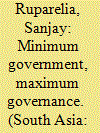

|
|
|
|
|
| Summary/Abstract |
This article examines the politics of development during the first year of the new Modi government. In particular, it explores the meaning of its guiding maxim, ‘Minimum Government, Maximum Governance’, by analysing specific reforms and broader changes in state–society relations. First, the Modi government has imposed greater discipline in public administration through a personalistic, centralised and technocratic style of rule. But it has bolstered executive power by limiting political transparency, parliamentary government and social dissent. Second, the new government has promoted urbanisation, manufacturing and infrastructure through greater economic liberalisation, public investment and institutional reform. Yet it has weakened many labour protocols, environmental regulations and participatory mechanisms regarding land acquisition and forest conservation. Lastly, the Modi administration has introduced new insurance schemes and championed digitally-enabled cash transfers to deliver social entitlements. However, it has reduced public spending on primary education and basic health, and undercut many rights-based welfare acts introduced by the previous administration, the United Progressive Alliance (UPA). These three trends have narrowed the spaces of power and contestation in contemporary Indian democracy, frustrating the promise of ‘maximum governance’.
|
|
|
|
|
|
|
|
|
|
|
|
|
|
|
|
| 7 |
ID:
142840


|
|
|
|
|
| Summary/Abstract |
During its first year in power (2014–15), the government of Narendra Modi in India showed itself to be a precarious enterprise. The prime minister was beset by multiple antagonisms. He radically centralised power. This has enabled him to get some things done swiftly, but it has weakened him by choking off reliable information flows from below and by sowing discontent among his party and his supporters. An exercise in fiscal decentralisation to the state level in this federal system ran counter to his centralisation, but on close examination, it proved less than generous. His efforts to tackle two problems—bureaucratic paralysis and high-level corruption—contradicted one another. His efforts to transcend the ambiguities which ensnare every prime minister were unrealistic and triggered further discontent among party colleagues. Finally, his handling of religious polarisation became entangled in multiple antagonisms—between the expectations of Hindu nationalists (and his own legacy as a polariser) and his duty to maintain social cohesion; between political gains to be made from polarisation and political costs that attend it; between polarisers who sought to strengthen his hand and those who sought to polarise in order to undermine him.
|
|
|
|
|
|
|
|
|
|
|
|
|
|
|
|
| 8 |
ID:
164902
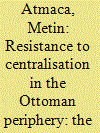

|
|
|
|
|
| Summary/Abstract |
Modern Kurdish historiography, which examines resistance to provincial centralisation in Ottoman Kurdistan, focuses largely on Bedir Khan’s Bohtan emirate and his revolt in the 1840s, while ignoring the rest of the other Kurdish emirates such as Baban emirate. While both states, Qajar Iran and Ottoman Empire, were endeavouring to solve their conflicts in the 1840s (a process which culminated in the treaty of Erzurum in 1847) the future of the Baban emirate and its territories emerged as one of the major issues during the course of negotiations. The Baban emirate was the last emirate to give up its struggle against the Sublime Porte’s centralisation reforms. The legacy of the Kurdish emirates is important to understand better the relations between the centre of the Ottoman Empire and its eastern periphery, a much less studied subject in Ottoman historiography. This article will highlight the impact of the centralisation policies in Kurdistan, more specifically on territories of the Bohtan and Baban emirates. It will be demonstrated that the changes wrought by the Tanzimat reforms were partially successful in transforming the Kurdish notables, who later became a part of the state bureaucracy. However, the reform-minded officials, who were appointed after the Kurdish emirs were removed from the region, failed to persuade the locals in favour of the new administration thus transforming their lives.
|
|
|
|
|
|
|
|
|
|
|
|
|
|
|
|
|
|
|
|
|